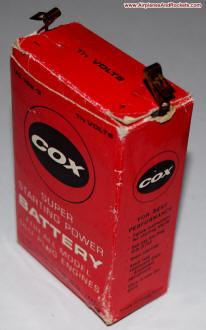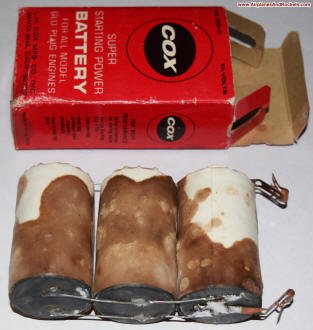|
  Long before rechargeable nickel-cadmium
(NiCad)
and nickel-metal-hydride (NiMH)
batteries were used for starting model airplane engines, we used standard
primary type
(non-rechargeable) 1.5-volt dry cells. In fact, the nominal 1.2-volt-per-cell potential
of NiCad and NiMH batteries were barely high enough to sufficiently light the ignition
coils in the glow heads and/or glow plugs, which were designed for 1.5 volts. Today's
glow plugs work just fine on 1.2 V or 1.5 V. Long before rechargeable nickel-cadmium
(NiCad)
and nickel-metal-hydride (NiMH)
batteries were used for starting model airplane engines, we used standard
primary type
(non-rechargeable) 1.5-volt dry cells. In fact, the nominal 1.2-volt-per-cell potential
of NiCad and NiMH batteries were barely high enough to sufficiently light the ignition
coils in the glow heads and/or glow plugs, which were designed for 1.5 volts. Today's
glow plugs work just fine on 1.2 V or 1.5 V.
I have written before about how as a kid on a very small modeling budget, I would
often spend a long time flipping the propeller of my Cox .049 engines while using
a single, worn-out D-cell battery (usually 'borrowed' from my father's only flashlight).
One Christmas my parents got me a field kit that included a can of 25% nitro Cox
fuel, a glow head clip, and a starting battery similar to the one shown here. This
battery came from eBay along with a plastic model I bought from someone. It is now
on display with the rest of the items in my collection of 'stuff' I used to have
as a kid. Of course all of my original stuff was destroyed or lost over the years
due to poor flying skills or neglect.
You can see in the photo that the Cox model 789-3 starting battery was comprised
of three 'D' cells wired in parallel to produce three times the current capacity.
If you are not familiar with how a glow plug works and why the glow element doesn't
burn out when more current is available, here's why. The element wire it nichrome
or some alloy thereof that is very sturdy and able to handle high temperatures.
It has what is termed a positive thermal coefficient of resistance, meaning that
as the temperature increases, so does the resistance. As long as the voltage supply
is not elevated past the designed operating voltage, current draw is limited by
the temperature of the element. If fuel on the element decreases its temperature,
the resistance decreases and the current, if available, will increase until the
element temperature is back to normal. That is why having a power supply with plenty
of current capacity is important for getting an engine started even when it is partially
flooded. In that way, the glow plug element acts sort of like a self-regulator to
keep the voltage constant.
The cardboard box size is 4-0" high by 2-1/2" wide by 1-3/8" deep. External battery
connection terminals are not included.
It is ultimately the current through the glow head element that will cause it
to burn out (fuse), so increasing the voltage too much can cause enough current
to flow to fry it. The more sophisticated field box power panels with built-in glow
plug supplies use a pulsed current output to keep the element at a constant temperature.
Those three leaky D cells have been discarded, BTW, but the wires and glow plug
clip attachment Fahnestock clips are taped in place for display purposes.
Website visitor George A. wrote to ask for the dimensions of the Cox starting
battery box so that he can create one using his printer. He also needed high resolution
images of all sides. The photos below show both sides of the flattened box, along
with a ruler for scale. The scans have not been edited except to move the terminal
clips closer to the box to keep file size down, so edit color and sharpness as you
deem fit.
 
|